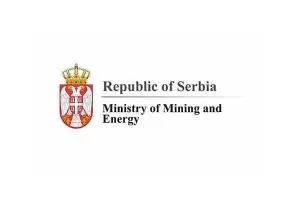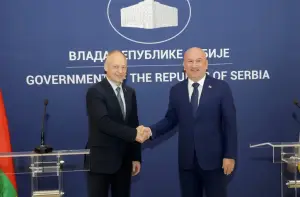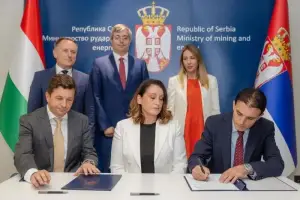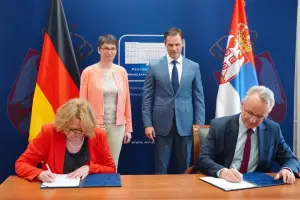Q:
A:
Foreign trade increases in January-October period
Belgrade,
30 November 2006
The Serbian Statistical Office stated today that Serbia's overall foreign trade in the period from January to October 2006 totalled $15,618 million, up by 22.9% compared to the same period in 2005. Expressed in euros, foreign trade reached €12,504 million, which is an increase of 29.6% in relation to the same period last year.
Exports stood at $5,140.3 million, up 42,3% compared to the same period last year, while imports totalled $10,477.7 million, a 23.4% increase in relation to the same period in 2005.
Expressed in euros, exports jumped 43.1% to €4,112.5 million, while imports went up 23.9% to €8,391.5 million in relation to the same period previous year.
Increased imports in the past ten months were a result of the import of energy sources which have reached $2,074 million, which is 19.8% of entire imports, as well as the import of copper and iron, which are used for production of elementary and other metals, and which currently have a favourable price on the world market.
The trade deficit for the period January-October 2006 stood at $5,337.4 million, up by 9.5% against the same period last year. Expressed in euros, the deficit stood at €4,279 million, up by 9.8% in relation to the same period last year.
The exports-to-imports ratio expressed in US dollars was 49%, showing a rise against the same period last year, when it stood at 42.5%. Expressed in euros, the ratio was 49%, whereas last year it was 42.4%.
The results for 2005 do not include values of trade exchange with Montenegro because at that time it was joined in a state union with Serbia, so that fact made the exports indexes much higher than they would have been had Montenegro been included in the results for last year.
Increased demand (public and private spending) also bore influence on the rise in imports. The increased availability of loans resulted in the increase of demand, which in turn affected the import. This is confirmed by the fact that the import of road vehicles in the period January-October was $764 million, which is 7.3% of the total import.
Increased exports were driven by the initial effects of privatisation and the restructuring of companies, by signed and ratified free trade agreements with signatory countries of the Stability Pact, by food (corn $57 million, sweet corn $38 million, sugar $37 million) and ready-made textile goods trade surplus, thanks to the agreement signed with the EU and preferential status of Serbian goods, as well as by an increase in world prices of basic metals and general economic activity.
The most exported items in the period January-October 2006 were intermediate goods accounting for 67.6% ($3,476.4.4 million), followed by consumer goods, which made up 26.8% ($1,375.9 million) and equipment, making up 5.6% ($288 million) of total exports.
Imports were dominated by intermediate goods accounting for 63.2% ($6,621 million), followed by consumer goods, 21.3% ($2,230.2 million) and equipment, 15.5% ($1,626.5 million).
Major importers of goods from Serbia were Italy ($725.4 million), Bosnia-Herzegovina ($605.1 million) and Montenegro ($525.8 million). The largest exporters to Serbia were Russia ($1,677.8 million), Germany ($1,008.1 million) and Italy ($844 million).
The greatest foreign trade was recorded in commerce with the EU, which accounted for more than half of total trade. The foreign trade surplus realised in commerce with Bosnia-Herzegovina was $336 million, whereas with Italy import figures equalled those of export.
Thanks to the free trade agreement, as well as the competitiveness of Serbian products, a surplus was also achieved in commerce with Macedonia, but the largest deficit remained in commerce with Russia, due to energy imports, mainly oil and natural gas.
Expressed in euros, exports jumped 43.1% to €4,112.5 million, while imports went up 23.9% to €8,391.5 million in relation to the same period previous year.
Increased imports in the past ten months were a result of the import of energy sources which have reached $2,074 million, which is 19.8% of entire imports, as well as the import of copper and iron, which are used for production of elementary and other metals, and which currently have a favourable price on the world market.
The trade deficit for the period January-October 2006 stood at $5,337.4 million, up by 9.5% against the same period last year. Expressed in euros, the deficit stood at €4,279 million, up by 9.8% in relation to the same period last year.
The exports-to-imports ratio expressed in US dollars was 49%, showing a rise against the same period last year, when it stood at 42.5%. Expressed in euros, the ratio was 49%, whereas last year it was 42.4%.
The results for 2005 do not include values of trade exchange with Montenegro because at that time it was joined in a state union with Serbia, so that fact made the exports indexes much higher than they would have been had Montenegro been included in the results for last year.
Increased demand (public and private spending) also bore influence on the rise in imports. The increased availability of loans resulted in the increase of demand, which in turn affected the import. This is confirmed by the fact that the import of road vehicles in the period January-October was $764 million, which is 7.3% of the total import.
Increased exports were driven by the initial effects of privatisation and the restructuring of companies, by signed and ratified free trade agreements with signatory countries of the Stability Pact, by food (corn $57 million, sweet corn $38 million, sugar $37 million) and ready-made textile goods trade surplus, thanks to the agreement signed with the EU and preferential status of Serbian goods, as well as by an increase in world prices of basic metals and general economic activity.
The most exported items in the period January-October 2006 were intermediate goods accounting for 67.6% ($3,476.4.4 million), followed by consumer goods, which made up 26.8% ($1,375.9 million) and equipment, making up 5.6% ($288 million) of total exports.
Imports were dominated by intermediate goods accounting for 63.2% ($6,621 million), followed by consumer goods, 21.3% ($2,230.2 million) and equipment, 15.5% ($1,626.5 million).
Major importers of goods from Serbia were Italy ($725.4 million), Bosnia-Herzegovina ($605.1 million) and Montenegro ($525.8 million). The largest exporters to Serbia were Russia ($1,677.8 million), Germany ($1,008.1 million) and Italy ($844 million).
The greatest foreign trade was recorded in commerce with the EU, which accounted for more than half of total trade. The foreign trade surplus realised in commerce with Bosnia-Herzegovina was $336 million, whereas with Italy import figures equalled those of export.
Thanks to the free trade agreement, as well as the competitiveness of Serbian products, a surplus was also achieved in commerce with Macedonia, but the largest deficit remained in commerce with Russia, due to energy imports, mainly oil and natural gas.










